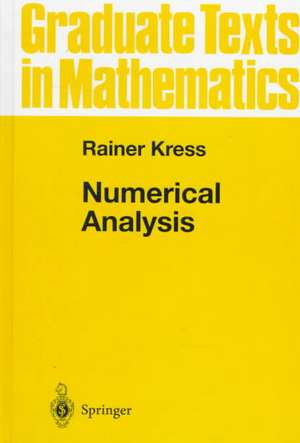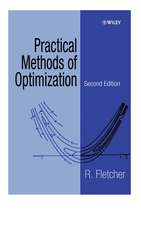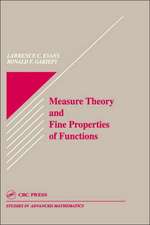Numerical Analysis: Graduate Texts in Mathematics, cartea 181
Autor Rainer Kressen Limba Engleză Hardback – 17 apr 1998
| Toate formatele și edițiile | Preț | Express |
|---|---|---|
| Paperback (1) | 490.46 lei 6-8 săpt. | |
| Springer – 27 sep 2012 | 490.46 lei 6-8 săpt. | |
| Hardback (1) | 533.72 lei 6-8 săpt. | |
| Springer – 17 apr 1998 | 533.72 lei 6-8 săpt. |
Din seria Graduate Texts in Mathematics
-
 Preț: 402.87 lei
Preț: 402.87 lei -
 Preț: 383.85 lei
Preț: 383.85 lei - 17%
 Preț: 366.56 lei
Preț: 366.56 lei - 17%
 Preț: 528.66 lei
Preț: 528.66 lei -
 Preț: 337.45 lei
Preț: 337.45 lei - 17%
 Preț: 398.97 lei
Preț: 398.97 lei -
 Preț: 355.82 lei
Preț: 355.82 lei -
 Preț: 411.83 lei
Preț: 411.83 lei -
 Preț: 404.47 lei
Preț: 404.47 lei -
 Preț: 289.88 lei
Preț: 289.88 lei - 17%
 Preț: 365.79 lei
Preț: 365.79 lei - 17%
 Preț: 359.45 lei
Preț: 359.45 lei - 15%
 Preț: 488.70 lei
Preț: 488.70 lei - 13%
 Preț: 357.75 lei
Preț: 357.75 lei -
 Preț: 407.88 lei
Preț: 407.88 lei - 13%
 Preț: 352.49 lei
Preț: 352.49 lei - 13%
 Preț: 358.86 lei
Preț: 358.86 lei - 13%
 Preț: 393.48 lei
Preț: 393.48 lei - 11%
 Preț: 351.00 lei
Preț: 351.00 lei - 17%
 Preț: 359.58 lei
Preț: 359.58 lei -
 Preț: 350.45 lei
Preț: 350.45 lei -
 Preț: 399.74 lei
Preț: 399.74 lei -
 Preț: 498.91 lei
Preț: 498.91 lei - 20%
 Preț: 571.26 lei
Preț: 571.26 lei - 15%
 Preț: 546.59 lei
Preț: 546.59 lei -
 Preț: 498.69 lei
Preț: 498.69 lei - 15%
 Preț: 354.39 lei
Preț: 354.39 lei -
 Preț: 313.10 lei
Preț: 313.10 lei - 13%
 Preț: 427.39 lei
Preț: 427.39 lei - 17%
 Preț: 363.59 lei
Preț: 363.59 lei -
 Preț: 340.18 lei
Preț: 340.18 lei - 17%
 Preț: 364.47 lei
Preț: 364.47 lei - 17%
 Preț: 366.47 lei
Preț: 366.47 lei - 17%
 Preț: 366.06 lei
Preț: 366.06 lei -
 Preț: 247.59 lei
Preț: 247.59 lei - 17%
 Preț: 367.70 lei
Preț: 367.70 lei - 13%
 Preț: 356.79 lei
Preț: 356.79 lei - 17%
 Preț: 398.78 lei
Preț: 398.78 lei - 17%
 Preț: 398.51 lei
Preț: 398.51 lei - 17%
 Preț: 496.63 lei
Preț: 496.63 lei - 15%
 Preț: 482.97 lei
Preț: 482.97 lei -
 Preț: 401.99 lei
Preț: 401.99 lei - 17%
 Preț: 366.56 lei
Preț: 366.56 lei - 20%
 Preț: 449.73 lei
Preț: 449.73 lei -
 Preț: 380.34 lei
Preț: 380.34 lei - 17%
 Preț: 427.27 lei
Preț: 427.27 lei
Preț: 533.72 lei
Preț vechi: 627.90 lei
-15% Nou
Puncte Express: 801
Preț estimativ în valută:
102.13€ • 107.12$ • 85.02£
102.13€ • 107.12$ • 85.02£
Carte tipărită la comandă
Livrare economică 01-15 aprilie
Preluare comenzi: 021 569.72.76
Specificații
ISBN-13: 9780387984087
ISBN-10: 0387984089
Pagini: 326
Ilustrații: XII, 326 p.
Dimensiuni: 155 x 235 x 21 mm
Greutate: 0.59 kg
Ediția:1998
Editura: Springer
Colecția Springer
Seria Graduate Texts in Mathematics
Locul publicării:New York, NY, United States
ISBN-10: 0387984089
Pagini: 326
Ilustrații: XII, 326 p.
Dimensiuni: 155 x 235 x 21 mm
Greutate: 0.59 kg
Ediția:1998
Editura: Springer
Colecția Springer
Seria Graduate Texts in Mathematics
Locul publicării:New York, NY, United States
Public țintă
Lower undergraduateCuprins
1 Introduction.- 2 Linear Systems.- 2.1 Examples for Systems of Equations.- 2.2 Gaussian Elimination.- 2.3 LR Decomposition.- 2.4 QR Decomposition.- Problems.- 3 Basic Functional Analysis.- 3.1 Normed Spaces.- 3.2 Scalar Products.- 3.3 Bounded Linear Operators.- 3.4 Matrix Norms.- 3.5 Completeness.- 3.6 The Banach Fixed Point Theorem.- 3.7 Best Approximation.- Problems.- 4 Iterative Methods for Linear Systems.- 4.1 Jacobi and Gauss—Seidel Iterations.- 4.2 Relaxation Methods.- 4.3 Two-Grid Methods.- Problems.- 5 Ill-Conditioned Linear Systems.- 5.1 Condition Number.- 5.2 Singular Value Decomposition.- 5.3 Tikhonov Regularization.- Problems.- 6 Iterative Methods for Nonlinear Systems.- 6.1 Successive Approximations.- 6.2 Newton’s Method.- 6.3 Zeros of Polynomials.- 6.4 Least Squares Problems.- Problems.- 7 Matrix Eigenvalue Problems.- 7.1 Examples.- 7.2 Estimates for the Eigenvalues.- 7.3 The Jacobi Method.- 7.4 The QR Algorithm.- 7.5 Hessenberg Matrices.- Problems.- 8 Interpolation.- 8.1 Polynomial Interpolation.- 8.2 Trigonometric Interpolation.- 8.3 Spline Interpolation.- 8.4 Bézier Polynomials.- Problems.- 9 Numerical Integration.- 9.1 Interpolatory Quadratures.- 9.2 Convergence of Quadrature Formulae.- 9.3 Gaussian Quadrature Formulae.- 9.4 Quadrature of Periodic Functions.- 9.5 Romberg Integration.- 9.6 Improper Integrals.- Problems.- 10 Initial Value Problems.- 10.1 The Picard—Lindelöf Theorem.- 10.2 Euler’s Method.- 10.3 Single-Step Methods.- 10.4 Multistep Methods.- Problems.- 11 Boundary Value Problems.- 11.1 Shooting Methods.- 11.2 Finite Difference Methods.- 11.3 The Riesz and Lax-Milgram Theorems.- 11.4 Weak Solutions.- 11.5 The Finite Element Method.- Problems.- 12 Integral Equations.- 12.1 The Riesz Theory.- 12.2 Operator Approximations.- 12.3 Nyström’s Method.- 12.4 The Collocation Method.- 12.5 Stability.- Problems.- References.
Caracteristici
Good introduction to an area experiencing rapid development for those in math, physics, and engineering. Gives a solid foundation by restricting the presentation to the basic principles and procedures, as well as the primary numerical algorithms. Includes the necessary functional analytic framework for a solid mathematical foundation in the subject. Gives particular emphasis to the question of stability. Presented in a concise and easily understandable fashion.

















